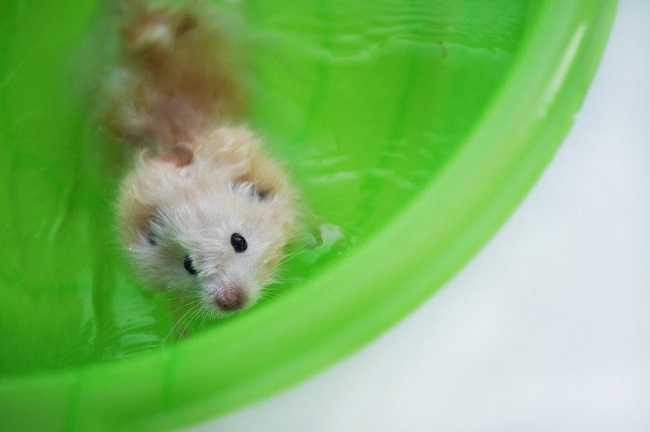Pet enthusiasts often ask about the swimming capabilities of their furry companions. One common query is, “Can hamsters swim?” Well, today we unravel the mystery surrounding Hamsters in Water.
With this in-depth guide, you’ll learn about the physiological, behavioral aspects, and potential hazards of placing Hamsters in Water, giving you all the information you need to ensure your little pet’s wellbeing.

Hamsters and Their Relationship with Water
Hamsters, contrary to what some may believe, aren’t naturally aquatic or semi-aquatic creatures. Their natural habitats are the dry, arid regions of Syria and Greece, which means water bodies aren’t commonly part of their living environments. Therefore, unlike ducks or even dogs, they aren’t instinctually equipped to swim.
Can Hamsters Swim?
Technically, yes, hamsters can swim. However, they do so out of necessity and not for pleasure. Their swimming mimics a doggy-paddle style, primarily used as a survival instinct when they accidentally find themselves in water. It is not an activity they would willingly engage in under normal circumstances.
The Risks of Putting Hamsters in Water
Here are some of the risks of putting Hamsters in Water:
Stress
Putting Hamsters in Water can cause them extreme stress. As mentioned, they are not naturally predisposed to swimming, so they may interpret such situations as life-threatening, leading to significant distress.
Hypothermia
Hamsters have a high body temperature, usually around 37.5 to 38 degrees Celsius. Placing them in water, especially cold water, can drastically reduce their body temperature, leading to hypothermia.
Dampening of Fur
Hamsters have dense fur which isn’t designed to handle water well. When soaked, their fur takes a long time to dry, and a damp hamster is more susceptible to illnesses.
Respiratory Issues
Hamsters are also prone to respiratory infections. Exposure to water, especially if it’s cold, can heighten the risk of such health problems.
Safe Interaction with Water: Bathing and Hydration
While swimming is not recommended for hamsters, they still need to interact with water for hydration and cleanliness. Hamsters should always have access to fresh, clean water for drinking.
As for bathing, hamsters are pretty good at grooming themselves. In case they get into something sticky or dirty, use a damp cloth or unscented pet wipes to clean them. Never submerge them fully in water.
Swimming Alternatives for Hamsters
While ‘Hamsters in Water’ isn’t an advisable scenario, it’s essential to provide your pet with physical activity alternatives to keep them happy and healthy.
Hamster Balls
Hamster balls provide an excellent opportunity for your hamster to explore and exercise while keeping them safe. They can roll around freely in the house, enjoying a change of environment. Just remember to supervise their adventure to ensure they don’t get stuck or roll down the stairs.
Running Wheels
Running wheels are a staple in hamster care. They offer an excellent outlet for your pet’s energy, mimicking the running they would do in the wild. Be sure to choose a solid wheel over one with rungs to avoid any injuries.
Maze and Tunnel Toys
Hamsters are burrowers in the wild, so they love to explore tunnels. You can purchase maze or tunnel toys specially designed for hamsters, or even build your own from cardboard tubes. This not only provides physical exercise but mental stimulation as well.
Dealing with Wet Hamsters: The Right Steps
Accidents can happen, and your hamster might end up wet. Here’s what to do if that occurs:
Gently Drying Your Hamster
If your hamster gets wet, it’s important to dry them immediately. Use a soft towel to gently blot the fur. Do not rub as it may cause their skin to get irritated.
Using a Hair Dryer
You may also use a hair dryer to dry your pet hamster but ensure that it’s set on the lowest heat setting or even a cool setting if available. Also, maintain a safe distance to prevent overheating or burns.
Keeping Them Warm
After drying your hamster, it’s vital to keep them warm to prevent any chances of hypothermia. Provide extra bedding and ensure the room temperature is sufficiently warm but not hot.
Conclusion
While the image of a hamster paddling around may seem adorable, it’s essential to remember that ‘Hamsters in Water’ is not a natural or comfortable scenario for these little creatures. Their interaction with water should be limited to drinking and minimal cleaning, ensuring their health and happiness.
Understanding your hamster’s natural instincts and limitations is vital for providing them with a safe and nurturing environment. Always prioritize your pet’s wellbeing over a potentially cute but dangerous activity.
























